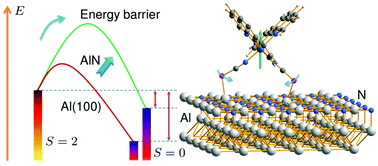Fe(phen)2(NCS)2 on Al(100): influence of AlN layer on spin crossover barrier
Abstract
We study how a nitride layer affects spin crossover (SCO) in a single Fe(phen)2(NCS)2 (Fephen) molecule adsorbed on the Al(100) surface using ab initio calculations. The Coulomb correlation of the open-shell 3d electrons has been considered using a Hubbard-U correction within different exchange–correlation approximations, including the van der Waals density functional. We determine the SCO energy barrier by computing the minimum energy path between the high-spin (HS) and low-spin (LS) states via direct constraint relaxations. It is shown that the HS–LS energy difference is slightly increased once deposited on Al(100), and thus LS states tend to be stabilized, as usually observed on metallic substrates. The oxidation of metallic Al to aluminum ions in the AlN layer promotes molecular adsorption, while it decreases HS–LS splitting, making Fephen switchable between its two spin states. Due to enhanced molecule–substrate bonding, the SCO barrier height is considerably increased, which may promote cooperativity. This effect is consistent with the AlN facilitated charge transfer at the interface that results from a reduction in surface work function. Our findings reveal the crucial role that surface electronic structure plays in maintaining spin bistability of the molecular adsorbate.



 Please wait while we load your content...
Please wait while we load your content...